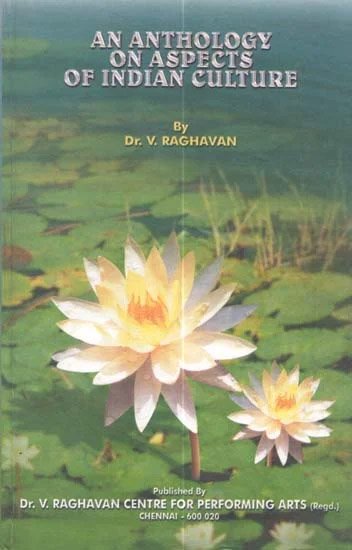An Anthology on Aspects of Indian Culture
author: Dr. V. Raghavan
edition: 2002, Dr. V Raghavan Institute of Performing Arts, Chennai
pages: 518
ISBN-10: 819219941X
ISBN-13: 9788192199412
Topic: History
Chapter 15 - Bhajans and Prayer
This chapter describes Bhajans and Prayer located on page 173 in the book An Anthology on Aspects of Indian Culture compiled by Dr. V. Raghavan. This book comprises a variety and integration in the pattern of Indian Culture. This theme is supported by another paper on ‘Religious Harmony’ which begins with an apt quotation form the Mahabharatha.
This present collection reveals, in essence, the multi-faceted approach of Dr. Raghavan, as a true and sincere torch-bearer of the best of ancient Indian cultural values. This volume—including Bhajans and Prayer—would certainly be of great interest to the young and the old, and to the lay and the learned alike.
This page contains an online preview of the full text and summarizes technical terms, as well as information if you want to buy this book.
Full contents not available online!
To read the full text of An Anthology on Aspects of Indian Culture, you can buy Dr. V. Raghavan’s book from Exotic India
You can look up the meaning of the phrase “Bhajans and Prayer” according to 22 books dealing with History. The following list shows a short preview of potential definitions.
Lord Jhulelal: An Analytical Study [by Thakkar Harish Gopalji]
Bhajans are a daily ritual in most of the temples of Lord Jhulelal during evening time, when people visit the temple to offer their prayers and respect to Lord Jhulelal. The Bhajan could be in Sindhi, Hindi, Kutchi or Gujarati or any regional languages. Sometimes they are composed in such way that they follow or copy some popular songs, tunes or Bhajans from Hindi cinemas of 70 s and 80 s. Many books comprising of Bhajans are published by the devotees of Lord Jhulelal for free distribution....
Read full contents: Part 4 - Oral tradition and literary religious sources
Triveni Journal
Though a South Indian Karnatic musician, she won the hearts of audiences in the North as well with her keerthanas and Bhajans. Her rendering of “Ghana Shyam Aayere”, a Meera Bhajan, won great acclaim in North India. “Vaishnava Janato. . ” was immensely liked by Gandhiji. She soon became a household name all over the country, her voice invoking gods and goddesses to bless mankind in the Suprabhatams and Sthothras rendered by her through recordings and cassettes....
Read full contents: M. S. Subbulakshmi
Folk Tradition of Bengal (and Rabindranath Tagore) [by Joydeep Mukherjee]
Traditionally one has to go through, just like a murid [disciple], sadhan and bhajans as directed or decided by Murshid [guru]. It is believed that directed way by the Tarik is the ideal way for spiritual emblem. ‘Haraik is one who knows/perceives the real meaning of the essence of God. ‘Maufat on the other hand signifies ‘real knowledge . Noticeably all the stages are the stages of escalation leading from one extreme of another....
Read full contents: Chapter 1.3 - Who are Bauls?
Total 22 books found: See all results here.
Summary:
You can return to the book Index to buy or shop for other books, or you can read the available online pages below:
[An Anthology on Aspects of Indian Culture: index]
[Foreword]
